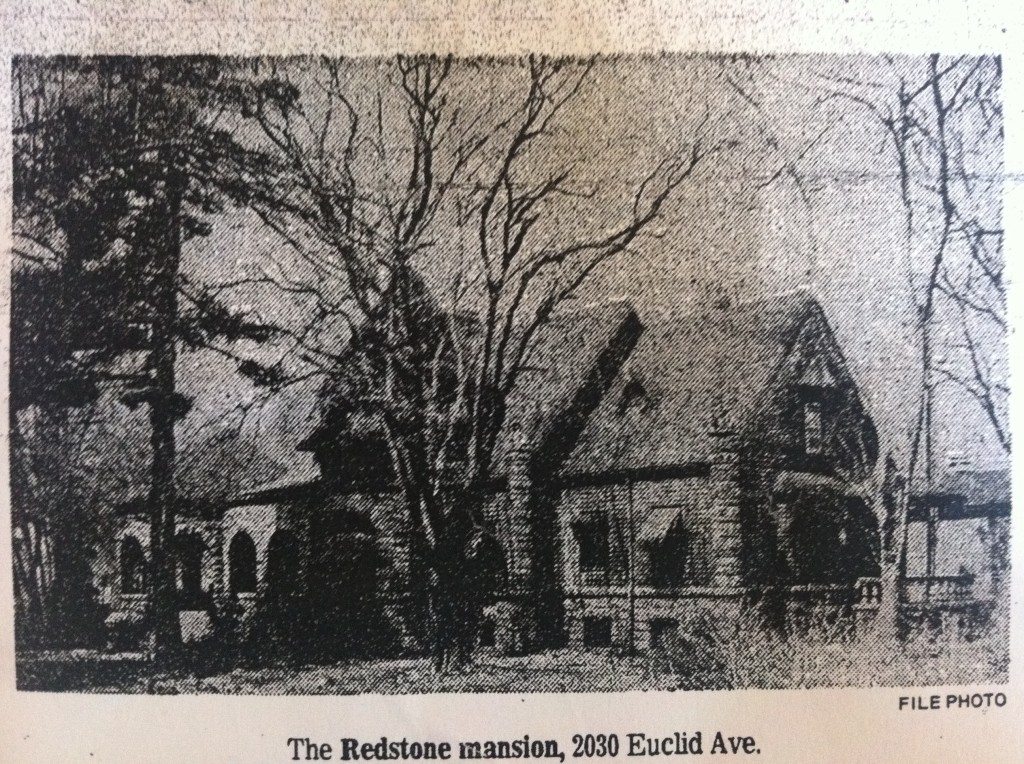This tour stop intended to encourage the driver to pause a while and gaze up the steep brick road between Sections 17 and 21 to the beautiful Allington family monument on the eastern tip of Section 18. (Walkers are encouraged to climb the hill and visit the monument up-close).
Dedicated in May 2005, a year following the death of Mary Lynn Allington (1931-2004), the pink granite arcade also marks the grave of her husband Robert W. Allington (1935-2006).
Mr. Allington was an engineer, chemist, inventor, and entrepreneur. He entered University of Nebraska at age 16 and completed a master’s degree in electrical engineering by 1961, despite having been stricken by paralyzing polio in 1955. He incorporated Isco to manufacture scientific instruments in 1958 and developed it into a global enterprise with $60 million annual sales by 2000.
The Allington’s are well-remembered in Lincoln for acquiring Maple Lodge on Euclid Street near South 20th in the early 1980s when the 1909 Shingle-style mansion was threatened with demolition. They carried out an exemplary rehabilitation of the National Register landmark and made it their family home, often opening it for special benefits. Their monument reflects their love of fine architecture, as well as Mr. Allington’s triumph over polio.
The monument incorporates a subtle, well-engineered ramp so that one can readily access it in a wheel chair. The inscriptions include a passage from Little Prince and ad an adaptation from the Korans: “If you have two loaves of bread, give one to the poor. Sell the other and buy hyacinths to feed your soul.”[/vc_column_text][spacer height=”5”][vc_column_text]
Robert graduated from Lincoln Northeast High and eventually followed in his father’s footsteps to UNL where he studied electrical engineering. During college, Robert took on an internship at the Massachusetts Institute of Technology in 1955, and his life forever changed. While in Boston, Robert contracted polio, resulting in hospitalization for two years and spending the rest of his life in a wheelchair. This experience gave Allington “a will to achieve” according to a 1975 Lincoln Star article. Allington went from being a B- student prior to this event, to an A- student, never falling below a 4.0.[/vc_column_text][spacer height=”5″][vc_column_text] [spacer height=”10″][/vc_column_text][spacer height=”5″][title type=”h1″ align=”center” color=”#79c043″]Awards[/title][spacer height=”20″][rev_slider_vc alias=”RobertAllingtonAwards”][vc_column_text][spacer height=”20″][/vc_column_text][/vc_column][vc_column width=”1/2″ animation=”” animation_delay=””][map_embed latitude=”40.81477″ longitude=”-96.66226″ zoom=”14″ border=”yes” styled=”yes” height=”400″][spacer height=”15″][vc_column_text]
[spacer height=”10″][/vc_column_text][spacer height=”5″][title type=”h1″ align=”center” color=”#79c043″]Awards[/title][spacer height=”20″][rev_slider_vc alias=”RobertAllingtonAwards”][vc_column_text][spacer height=”20″][/vc_column_text][/vc_column][vc_column width=”1/2″ animation=”” animation_delay=””][map_embed latitude=”40.81477″ longitude=”-96.66226″ zoom=”14″ border=”yes” styled=”yes” height=”400″][spacer height=”15″][vc_column_text]
Place of Rest
Wyuka Cemetery
3600 “O” Street | Lincoln, NE 68510 | 402.474.3600
[/vc_column_text][spacer height=”8″][title type=”h1″ align=”left” color=”#79c043″]Career[/title][spacer height=”8″][vc_column_text]In 1957, while still in the hospital undergoing treatment (with breaks on the weekends), Robert formed a business partnership with Jacob Schafer, a fellow undergraduate at UNL, to make special order laboratory equipment together. Robert did the designing and electronic work, and Schaefer did the machine shop. Their first highly successful product was a fraction collector.
While on Thanksgiving break in 1959, Allington put finishing touches on the latest invention—a Buck Rogers device— a system with a radio transmitter placed in a cow’s stomach to broadcast pressure readings to a receiver and recorder. The invention resulted in a $10,000 profit. With the profits from the radio “cow transmitter,” the business took off.
Allington founded Instrumentation Specialties Company (ISCO) in 1960, though its early roots began in his garage in 1958. His business partner, Schaefer, had left to pursue a different business venture by the time ISCO started. The business specialized in creating scientific gadgetry used in a variety of facets. ISCO’s products were quickly found all over the world—for cancer research, sewage, brewery purposes and beyond. Most of the company’s products were sophisticated equipment used for medical research, according to a 1975 Lincoln Start article (see below).
The company became a $60-million-plus global venture with nearly 400 employees. ISCO specialized in two major divisions—separation and environmental instrumentation. Allington served as chairman, president and CEO throughout his career, while remaining active in the research and innovation behind its products.
In 2004, ISCO merged with Teledyne Technologies. Allington held more than 200 U.S. and foreign patents throughout his lifetime.[/vc_column_text][spacer height=”5″][vc_column_text] [spacer height=”8″][/vc_column_text][spacer height=”8″][title type=”h1″ align=”left” color=”#79c043″]Philanthropy[/title][vc_column_text][spacer height=”8″]Robert was a philanthropist and activist through public service and dozens of organizations throughout his life. He served on the city and county’s planning commission, notably as a chairman for two years. Robert was vital in helping start Lincoln’s first health maintenance organization. He was also chairman of the State Crippled Childrens Committee, among other worthy causes.
[spacer height=”8″][/vc_column_text][spacer height=”8″][title type=”h1″ align=”left” color=”#79c043″]Philanthropy[/title][vc_column_text][spacer height=”8″]Robert was a philanthropist and activist through public service and dozens of organizations throughout his life. He served on the city and county’s planning commission, notably as a chairman for two years. Robert was vital in helping start Lincoln’s first health maintenance organization. He was also chairman of the State Crippled Childrens Committee, among other worthy causes.
While serving on the planning commission, Robert bought the Redstone mansion, 2030 Euclid Ave., to preserve it for community activities. Robert paid $193,000 for the house, which was built in 1909. More details can be found in a Lincoln Star article below.[/vc_column_text][spacer height=”8″][vc_column_text][row margin_top=”5px” margin_bottom=”5px”]
[/row][/vc_column_text][/vc_column][/vc_row][vc_row full_width=”” parallax=”” parallax_image=”” animation=”” animation_delay=”” fullwidth=”no” bg_type=”solid_color” bg_repeat=”no-repeat” video_texture=”” fw_columns=”” fw_same_height=”” border=”” waved_border_top=”” waved_border_bottom=”” top_margin=”0″ bottom_margin=”0″ el_id=””][vc_column width=”1/1″ animation=”” animation_delay=””][spacer height=”10″][/vc_column][/vc_row]

